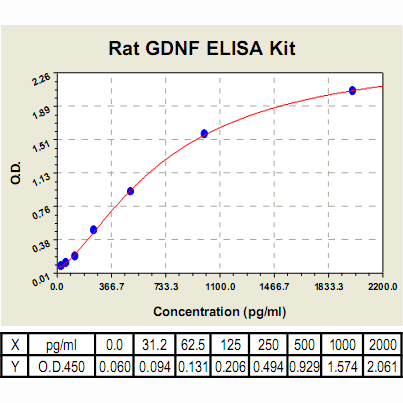GDNF ELISA Kit, Rat |
 |
BACKGROUND Glial cell line–derived neurotrophic factor (GDNF) is a distant member of the TGF-beta protein family that is essential for neuronal survival. GDNF and related ligands, neurturin (NRTN), artemin (ARTN) and persephin (PSPN), maintain several neuronal populations in the central nervous systems, including midbrain dopamine neurons and motoneurons. In addition, GDNF, NRTN and ARTN support the survival and regulate the differentiation of many peripheral neurons, including sympathetic, parasympathetic, sensory and enteric neurons. GDNF has further critical roles outside the nervous system in the regulation of kidney morphogenesis and spermatogenesis.1
GDNF family ligands bind to specific GDNF family receptor alpha(GFR-alpha) proteins, all of which form receptor complexes and signal through the RET receptor tyrosine kinase. In the absence of ligand, most glycosyl phosphatidylinositol (GPI)-anchored GFRalpha molecules are in membrane rafts, some weakly bound to RET, and most RET is outside the rafts. GDNF might induce GFRalpha dimerization. The enhanced affinity of the GDNF–GFRalpha complex to RET drags RET to the rafts and promotes its dimerization, which leads to activation and autophosphorylation of RET. Four tyrosine residues in the RET intracellular part (Tyr905, Tyr1015, Tyr1062 and Tyr1096) serve as docking sites for different adaptors. RET stimulation in trans by GDNF bound to soluble GFRalpha outside the rafts initially activates signalling pathways that are mediated by soluble adaptors such as Shc. The soluble GDNF–GFRalpha complex recruits RET to lipid rafts and triggers raft-specific signalling. Although both FRS2 (fibroblast growth factor receptor substrate 2) and Shc adaptors can bind to the same phosphotyrosine (Tyr1062), RET stimulation by GPI-anchored GFRalpha in rafts promotes the binding of lipid-anchored adaptors such as FRS2 and the activation of Src. Three other adaptor proteins — DOK4/5 (downstream of tyrosine kinase 4/5), IRS1/2 (insulin receptor substrate 1/2) and enigma — bind to the same Tyr1062 site. Binding of enigma to RET is independent of phosphorylation. The adaptors will mediate the downstream signalings including PI-3 kinase/Akt and MAP kinase activation.2
The neurotrophic effect of GDNF, except in motoneurons, requires the presence of transforming growth factor beta, which activates the transport of GFR-alpha1 to the cell membrane. GDNF can also signal RET independently through GFR1-alpha. Upon ligand binding, GDNF in complex with GFR-alpha1 may interact with heparan sulphate glycosaminoglycans to activate the Met receptor tyrosine kinase through cytoplasmic Src-family kinases. GDNF family ligands also signal through the neural cell adhesion molecule NCAM. In cells lacking RET, GDNF binds with high affinity to the NCAM and GFR-alpha1 complex, which activates Fyn and FAK. In animal and cell culture experiments, it is conceivable that GDNF signaling protects against the acute effects of toxins, revives already injured neurones, promotes axonal regeneration, or is able to exert all of these effects.3
GDNF family ligands bind to specific GDNF family receptor alpha(GFR-alpha) proteins, all of which form receptor complexes and signal through the RET receptor tyrosine kinase. In the absence of ligand, most glycosyl phosphatidylinositol (GPI)-anchored GFRalpha molecules are in membrane rafts, some weakly bound to RET, and most RET is outside the rafts. GDNF might induce GFRalpha dimerization. The enhanced affinity of the GDNF–GFRalpha complex to RET drags RET to the rafts and promotes its dimerization, which leads to activation and autophosphorylation of RET. Four tyrosine residues in the RET intracellular part (Tyr905, Tyr1015, Tyr1062 and Tyr1096) serve as docking sites for different adaptors. RET stimulation in trans by GDNF bound to soluble GFRalpha outside the rafts initially activates signalling pathways that are mediated by soluble adaptors such as Shc. The soluble GDNF–GFRalpha complex recruits RET to lipid rafts and triggers raft-specific signalling. Although both FRS2 (fibroblast growth factor receptor substrate 2) and Shc adaptors can bind to the same phosphotyrosine (Tyr1062), RET stimulation by GPI-anchored GFRalpha in rafts promotes the binding of lipid-anchored adaptors such as FRS2 and the activation of Src. Three other adaptor proteins — DOK4/5 (downstream of tyrosine kinase 4/5), IRS1/2 (insulin receptor substrate 1/2) and enigma — bind to the same Tyr1062 site. Binding of enigma to RET is independent of phosphorylation. The adaptors will mediate the downstream signalings including PI-3 kinase/Akt and MAP kinase activation.2
The neurotrophic effect of GDNF, except in motoneurons, requires the presence of transforming growth factor beta, which activates the transport of GFR-alpha1 to the cell membrane. GDNF can also signal RET independently through GFR1-alpha. Upon ligand binding, GDNF in complex with GFR-alpha1 may interact with heparan sulphate glycosaminoglycans to activate the Met receptor tyrosine kinase through cytoplasmic Src-family kinases. GDNF family ligands also signal through the neural cell adhesion molecule NCAM. In cells lacking RET, GDNF binds with high affinity to the NCAM and GFR-alpha1 complex, which activates Fyn and FAK. In animal and cell culture experiments, it is conceivable that GDNF signaling protects against the acute effects of toxins, revives already injured neurones, promotes axonal regeneration, or is able to exert all of these effects.3
REFERENCES
1. Baloh,R.H. et al: Curr. Opin. Neurobiol. 10:103-10, 2000
2. Airaksinen,M.S. & Saarma, M.: Nat. Rev. Neurosci. 3:383-394, 2002
3. Sariola1, H. & Saarma, M.: J. Cell Sci. 116:3855-62, 2003
2. Airaksinen,M.S. & Saarma, M.: Nat. Rev. Neurosci. 3:383-394, 2002
3. Sariola1, H. & Saarma, M.: J. Cell Sci. 116:3855-62, 2003
Products are for research use only. They are not intended for human, animal, or diagnostic applications.
Параметры
Cat.No.: | CL0363 |
Target Protein Species: | Rat |
Range: | 31.2 pg/ml – 2000 pg/ml |
Specificity: | No detectable cross-reactivity with other cytokines |
Storage: | Store at 4°C. Use within 6 months. |
ELISA Kits are based on standard sandwich enzyme-linked immunosorbent assay technology. Freshly prepared standards, samples, and solutions are recommended for best results.
Документы
Информация представлена исключительно в ознакомительных целях и ни при каких условиях не является публичной офертой








